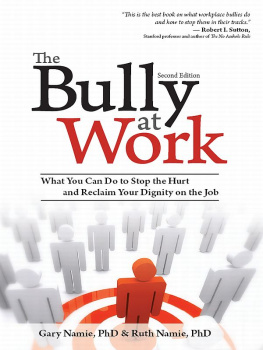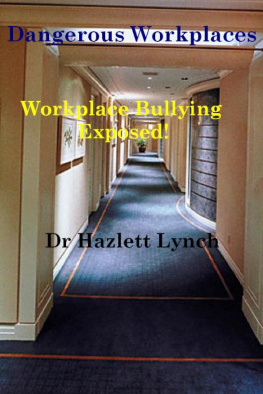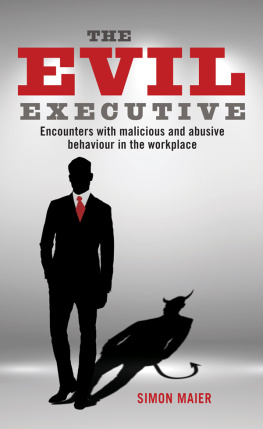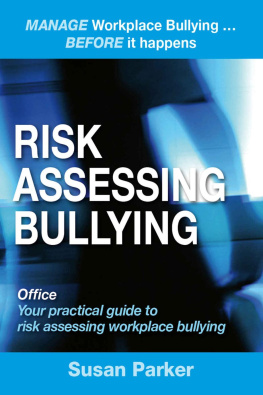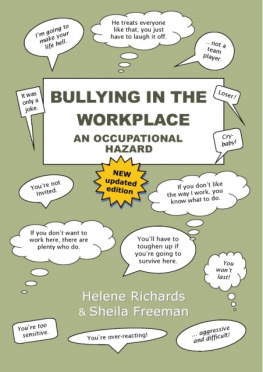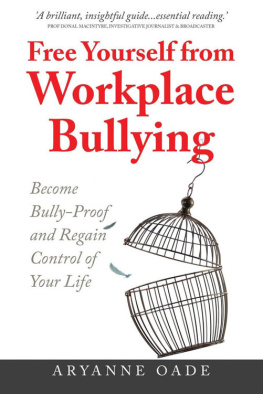Copyright 2011 Gary Namie, PhD, and Ruth F. Namie, PhD. All rights reserved.
Published by John Wiley & Sons, Inc., Hoboken, New Jersey.
Published simultaneously in Canada.
No part of this publication may be reproduced, stored in a retrieval system, or transmitted in any form or by any means, electronic, mechanical, photocopying, recording, scanning, or otherwise, except as permitted under Section 107 or 108 of the 1976 United States Copyright Act, without either the prior written permission of the Publisher, or authorization through payment of the appropriate per-copy fee to the Copyright Clearance Center, Inc., 222 Rosewood Drive, Danvers, MA 01923, (978) 750-8400, fax (978) 646-8600, or on the web at www.copyright.com . Requests to the Publisher for permission should be addressed to the Permissions Department, JohnWiley & Sons, Inc., 111 River Street, Hoboken, NJ 07030, (201) 748-6011, fax (201) 748-6008, or online at http://www.wiley.com/go/permissions .
Limit of Liability/Disclaimer of Warranty: While the publisher and author have used their best efforts in preparing this book, they make no representations or warranties with respect to the accuracy or completeness of the contents of this book and specifically disclaim any implied warranties of merchantability or fitness for a particular purpose. No warranty may be created or extended by sales representatives or written sales materials. The advice and strategies contained herein may not be suitable for your situation. You should consult with a professional where appropriate. Neither the publisher nor author shall be liable for any loss of profit or any other commercial damages, including but not limited to special, incidental, consequential, or other damages.
For general information on our other products and services or for technical support, please contact our Customer Care Department within the United States at (800) 762-2974, outside the United States at (317) 572-3993 or fax (317) 572-4002.
Wiley also publishes its books in a variety of electronic formats. Some content that appears in print may not be available in electronic books. For more information about Wiley products, visit our website at www.wiley.com .
ISBN 978-0-470-94220-8 (cloth); ISBN 978-1-118-06724-6 (ebk); ISBN 978-1-118-06728-4 (ebk); ISBN 978-1-118-06729-1 (ebk)
To Ike, beloved by all
Bullies cannot exist unless the Employer tacitly permits or encourages bullying behavior.
Bernice L. Fields
Foreword
Gary and Ruth Namie are heroes. No one has worked harder, longer, and more successfully to stem the tide of workplace bullying in the United States and beyond. They started with a more general approach with The Work Doctor, but narrowed their focus some 15 years ago to become the world's leading crusaders against the jerks, weasels, and snakes who infect our organizationsand for too many of usthe teams and workgroups that we find ourselves in at this very moment. This book, The Bully-Free Workplace , brings together their wisdom, passion, dedication to hard facts, and relentless attention to practical solutions.
Many crusaders become so wrapped up in their goals that they lose the ability to make fact-based decisions and to give valid advice. The Bully-Free Workplace does a splendid job of avoiding this problem, bringing the most rigorous evidence available to the table. One of the most difficult problems associated with studying workplace abuse and related topics is that there are so little valid data about prevalence and patterns. We all should be skeptical of web-based surveys that are answered by biased samples, which often reflect a dedication to some political motive rather than to discovering the truth. By far, the most useful and rigorous surveys on bullying have been conducted by the Namies' Workplace Bullying Institute in conjunction with Zogby, a respected survey research firm. The results of this research are important in many ways, showing, for example, the huge amount of money that workplace bullying costs organizations and the diverse ways in which such abuse damages victims' emotional, physical, and financial well-being.
In particular, these studies provide strong evidence to justify the Namies' focus on organizations and people in positions of power as root causes of workplace bullying. Yes, the Namies show how personality and upbringing can play a role in creating people who are prone to bullying their peers and followers. Yes, they provide detailed and useful advice about how victims can fight against their tormentors. But I believe that the most important and impressive contribution of this useful and compelling book is that it demonstrates that when workplace bullying happens, the organizations where it happens (and the people who have leadership and managerial positions in them) are the primary culprits and even more important, the primary point of intervention for creating bully-free workplaces.
Perhaps the single most important takeaway for me was, as the Namies' advise in Chapter 5, that leaders and organizations ought to start by drawing a firm line in the sand. Drawing a line in the sand, as the Namies show us, is so important because even small incidents of bullyingthose little glares and insults, for exampleare dangerous signs that more vile and damaging behavior exists or will be tolerated. Once the decision has been made to draw a line in the sandto me the single most important decisionthen both the motivation and logic for building a bully-free workplace start falling into place. Then the range of powerful methods that are proposed and explained here can be applied to each context.
In particular, I urge every boss to study the Namies' list in Chapter 5 of a dozen ways to intervene when bullying incidents happen. Unfortunately, this list runs counter to what happens in most organizations that I know, and if just this set of practices alone were used widely, enormous progress would be made toward building workplaces where jerks, weasels, snakes, and tyrants either change their ways or run for the exits. Consider the Namies' vehement advice: Do not attempt to put the bully and target across the table from one another to find common ground (mediation) unless the bullying has caused no severe consequences for the target. Yet, time after time, bosses and victims tell me horror stories about the results of forcing victims and their tormentors to work it out together even though the victim is terrified of the bully andespecially in the case of smart, powerful, and deluded bulliessuch conversations provoke a round of revenge that makes the victim suffer even more.
This is just one small example; The Bully-Free Workplace is chock full of other equally useful tips. I especially like how the Namies take considerable pains to show how people in positions of power often do things that unwittingly make it safe for bullies to do their dirty work or, worse yet, are bullies themselves (but are unable or unwilling to admit it to themselves). As I've written elsewhere, especially when people are in power and work under severe pressure, the chances that they will act like assholes and treat people with less power like dirt are quite high. The Namies provide remarkably helpful action stepsdeveloped through their years of practical experienceto help workplace bullies, and those who enable these jerks to do their dirty work, to reverse their vile and destructive ways. I was especially pleased to read that We've been tough on executives with our candor that they need to stop coddling friends who are bullies. We even invited them to gauge whether or not they are the problem themselves. The next step is for people in power to be as tough on themselves as the Namies are on them!


